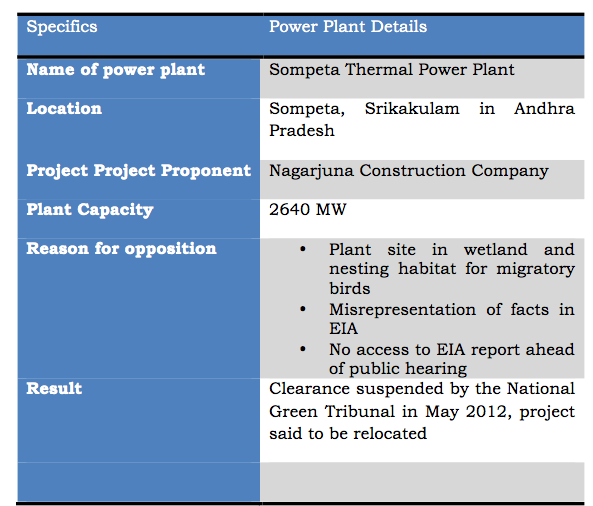In 2008, the State government of Andhra Pradesh permitted Nagarjuna Construction Company to construct a 2,640 MW thermal power plant in Sompeta, Andhra Pradesh.
The Expert Appraisal Committee did not issue the Terms of Reference at the first instance noting that the project land involved marshy sites, and asked the Project Proponent to find an alternate site away from the mudflats, conforming to CRZ Regulations. The Project Proponent informed the EAC that the project site was neither a wetland nor in the CRZ area, and the information provided by it earlier was based on errors. The site visit report by a sub-committee of the EAC stated that the project area was dry, agricultural land. Based on the site visit report, a TOR was issued in May 2009, after asking the Project Proponent to exclude a specific area of 400 acres. A public hearing conducted in August, and environmental clearance granted by MOEF in December. Subsequently, in early 2010, petitions were filed at the National Environmental Appellate Authority (NEAA) against the clearance.

Due to the massive land acquisition involved in the project, residents were aware of the project. Their concerns were initially voiced by a regional NGO, Paryavarana Parikakshana Samithi (PPS), which wrote letters to the SPCB, Regional MoEF offices and the Chief Minister. An overwhelming majority of the public is said to have opposed the plant at the public hearing. The primary objection of the people was about the falsification of facts regarding the type of land.
The state government allotted land to NCC based on a report by the Collector of Srikakulam about the government lands to be alienated to the company. This excluded 44.6 ha of land under agriculture and the area within the Coastal Regulation Zone. Later in 2009, through another order, these were included in the area to be allotted to the company. The Collector’s report failed to disclose three lift irrigation projects operating there. This despite the fact that in 2003, the government had issued an instruction to all the District Collectors to notify all lands with water bodies and include them in the village ‘Prohibitory Order Books’ so that such land could be excluded from diversion and damage. The Collector’s report suppressed this fact and described the land in question as “wasteland” and “non-cultivable”, in order to pave the way for allotting it to NCC.
The plant site is a nesting and feeding habitat for migratory birds from Australia and Siberia, which visit the area for six months and within a wetland where no industrial activity can be permitted under the Environment Protection Act (EPA), 1986.
The project- if implemented- would have affected the villages of Rushikudda, Gollagunda, Baruvapeta and Benkili which are inhabited by both peasants and fishermen.
Local communities opposed the clearance issued for the project claiming it was granted based on misleading facts. PPS filed a petition against the Environment Clearance, claiming that it was granted based on misleading facts in the EIA.
Meanwhile, in July 2010, the Project Proponent initiated land acquisition which resulted in a fight between the Project Proponents and police on one side, and more than a thousand villagers on the other. The local police opened fire on the farmers and fisherman, killing two fishermen. In addition, 150 people were injured, including 45 policemen.
Two days after the police firing, the NEAA cancelled the environment clearance for the project, stating that:
“On inspection, the Authority found this land a typical wetland of great ecological importance and a source of water for nearby villages upon which three important lift irrigation projects of the Government depend. The reports of various agencies including that of sub-committee of EAC was found misleading”, (Paragraph-6) and “ the Authority has no doubt that the area in question is a typical wetland of great ecological significance and despite no law prohibiting its use for power plant, will not permit its use for that purpose” (Paragraph-9).”
Following the NEAA order, the Project Proponents filed six review petitions, which were transferred to the National Green Tribunal. In May 2012, the NGT suspended the clearance issued to the project[1]. The bench noted that the baseline data was collected before the TOR was issued, and the time for several surveys were not specified in the EIA report. The tribunal also noted that in the public hearing process, the people were deprived of information about the project as there was no access to the EIA Report. Based on these observations, the NGT asked that the EC for the project remain suspended.[2] Meanwhile, the Project Proponent company announced that the project has been relocated to Krishnampatnam.[3]
[1]http://epaper.timesofindia.com/Default/Scripting/ArticleWin.asp?From=Ar…
[2]https://www.elaw.org/system/files/SompetaJudgment.pdf
[3]http://www.infrawindow.com/news/national-green-tribunal-cancels-clearan…

